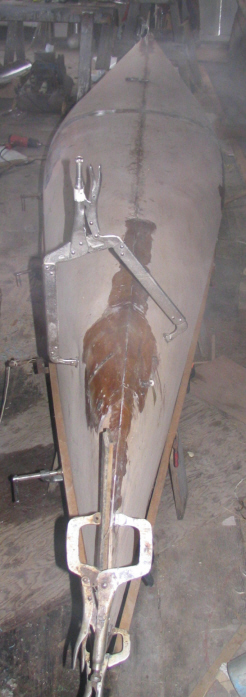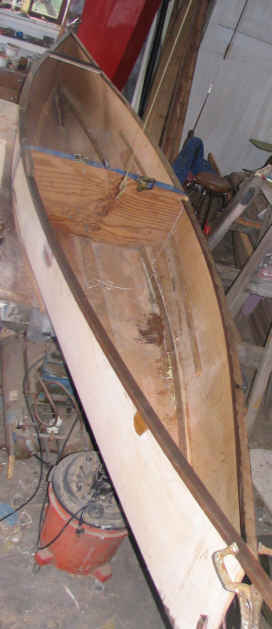Canuda
Ply Design LOA 15’9”. beam 33". 14" high amidships 20" bow, weight
40 lb.
Drink Canada Dry. Think Canuda Ply.
Canu for canoe, Ply for 2 sheets of plywood . The aim of this prototype is to
show that a canoe can be made from flat plywood with great economy of wood and
resin. Plywood compared to fiberglas laminates has cheap renewable fibers and because
of the very high steam pressing pressures very low consumption of a cheap
thermosetting resin. The possibility exists of mass
producing the halves of the canoe and bulk shipping them nested so that all
the homebuilder has to do is join them along the keeline and stem and stern
and finish the wood. Since plywood with scarf joints can be
tortured into narrow kayaks, it was hoped that the hot rolling and
broadseaming techniques pioneered by the Arrow would allow a round bilge
plywood canoe. It did not prove possible to get a smooth joint with the
large amount of broadseam required and a dart had to be introduced
perpendicular to the seam. To ensure both the dart and the fore and aft
seam was perfectly smooth, a female mold was made of the midships chine
area on one side of a fiberglas canoe
Each panel was placed on the mold to glass its chine dart closed on
the outside with a ply bridging strip glued over it on the inside. The mold
was also used to close and to glass- reinforce the spline joint between
fore and aft panels on each side. Generally a female mold avoids any outside high spots which are
impossible to fair without breaking through the outside veneer, and
prioritises the outside fairness in contact with the the water. 1) get a high
overall prismatic fullness coefficient Cp more from the stern than the bow 2) to avoid solo sitting right at the center
where the carrying yoke has to be I widened the
side stringers more at the stern than at the bow to get more U to the stern
quarter sections. The V'd bow sections reject spray and allow a classic
canoe bow radius and the bow to run up beaches, rocks, and flotsam rather
than ploughing into them. The very small radius stern profile should be good
for directional stability and hanging a rudder for sailing or trimming. If kayaks with no yaw from paddling have rudders
for the wind, canoes have even more reason to have such trim tabs Aesthetically
the stern from the side looks acceptably
like a square stern canoe. The
low rocker helps with directional stability for lake canoeing. The flared
quarter sections are good for rejecting spray and overtopping from lake
waves, and give very good secondary stability in roll and pitch. The
vertical sides and the inside gunnel amidships provide clearance for the
hand closest to the blade in solo paddling as close to the centerline as
possible. The knees can be braced against the chines so that switching
paddling sides every few strokes or longer does not require shifting the
stance if the waterline beam is about 30". The heeling of a narrow canoe in solo
paddling generates a yaw torque that
counters the one from the offcenter paddle. The power stance of bending the away leg at the knee with the
foot forward requires even less beam than double kneeling. Hence the beam
is 30” on the waterline and 34” max with the gunnel 13” high amidships
rising to 20 ” at the bow. The canoe signature features of a sharp
upturn in the sheer at the ends and recurve of the stem are no problem to
incorporate. The upturn is as sharp as possible so as not to generate alot of windage and
the gunnel transitions to mainly on the outside so as to help reject
overtopping from oncoming waves But
at the stern with its no rocker U sections the sheer has been kept fairly
low, and as amidhsips the gunnel is mainly on the inside These features
will be necessary for a new rentry strategy based on the front seat being a
very thick foam bulkhead. The plan is to swim the bow of the inverted swamped
canoe downwind, force it under water, and have the wind help drain and blow
the canoe vertical floating at the foam seat and then allow it to blow back
upright quickly so only the bow compartment is flooded. Then swim around to
the stern and hoist one self over it with ones legs intially dangling on
the outside, with the flooded bow compartment counterbalancing one's
weight. This stern reentry works on dinghies where side rentry is
impossible. If successful here it will mean much less bailing than trying
to bail out an entire canoe's volume of water against overtopping waves. 

The undarted front of each panel then is the midsection shape angling toward the bow. To
